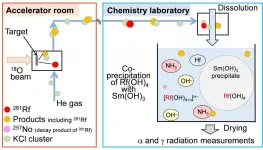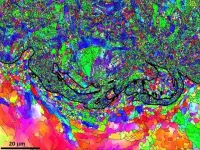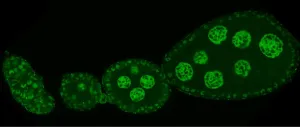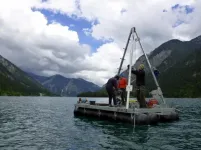(Press-News.org) Researchers from the Oil and Gas Research Institute of the Russian Academy of Sciences and their Skoltech colleagues have surveyed the newest known 30-meter deep gas blowout crater on the Yamal Peninsula, which formed in the summer of 2020. The paper was published in the journal Geosciences.
Giant craters in the Russian Arctic, thought to be the remnants of powerful gas blowouts, first attracted worldwide attention in 2014, when the 20 to 40-meter wide Yamal Crater was found quite close to the Bovanenkovo gas field. The prevailing hypothesis is that these craters are formed after gas is accumulated in cavities in the upper layers of permafrost, and increasing pressure ultimately unleashes an explosive force. Most of these craters are rather short-lived as they apparently quickly fill with water over several years and turn into small lakes. As of now, there are some 20 known and studied craters.
In 2020, researchers found and surveyed the latest crater, dubbed C17, about 25 meters in diameter. It was found by Andrey Umnikov, director of the non-profit partnership "Russian Center of Arctic Development," during a helicopter flight on July 16 in the central part of the Yamal Peninsula, close to three other craters including the famous Yamal Crater. OGRI deputy director Vasily Bogoyavlensky led the August 2020 expedition, which was possible thanks to the generous support of the government of Yamalo-Nenets Autonomous Area and Mr Umnikov's organization. Evgeny Chuvilin and Boris Bukhanov from the Skoltech Center for Hydrocarbon Recovery took part in the expedition.
"The new crater is impressive in its ideal state of preservation, primarily the cone-shaped top where ejecta was thrown from, the outer parts of the heaving mound that precipitated the crater, the walls of the crater itself which are incredibly well preserved, and, of course, the gas cavity in the icy bottom of the crater," Chuvilin says.
"Firstly, we got there in time to find the object in its almost pristine state, with no water filling it. Secondly, the giant underground cavity in the ice is unique in itself. A part of the icy dome of this cavity was preserved; before the explosion, it had this circular dome, and its bottom was elliptical, elongated to the north, with its axis ratio of approximately 1 to 4.5. From what we know we can say that the C17 crater is linked to a deep fault and an anomalous terrestrial heat flow," Bogoyavlensky notes.
A certified pilot, Igor Bogoyavlensky, piloted the drone used for crater surveillance. That was the first time a drone flew inside the crater for "underground aerial survey" 10 to 15 meters below ground, running the risk of losing the aircraft. The team used the data to build a 3D model based on the drone footage from inside the crater. This is the first time scientists were able to study a "fresh" crater that has not yet eroded or filled with water, with a well-preserved ice cavity where gas had been accumulating. 3D modeling was earlier used for the Yamal Crater, but at the time it was already filled with water.
"Over the years we've gained a lot of experience with surveillance drones, yet this "underground aerial survey" of the C17 crater was the most difficult task I had ever faced, having to lie down on the edge of a 10-story deep crater and dangle down my arms to control the drone. Three times we got close to losing it, but succeeded in getting the data for the 3D model," Igor Bogoyavlensky, the drone pilot, says.
Vasily Bogoyavlensky says the 3D model allowed them to capture the extremely complex shape of the underground cavity. "We could not see everything from above, especially the grottos, possible caverns in the lower part of the crater. You can clearly see all that with the 3D model. Our results suggest unequivocally that the crater was formed endogenously, with ice melting, a heaving mound dynamically growing due to gas accumulation and the explosion," he adds.
The Skoltech researchers were able to study the cryogeological conditions of the crater, the composition of permafrost in this area as well as ejecta from the crater, temperature conditions at the crater floor and some other parameters. "This information will shed light on the conditions and formation of these unusual objects in the Arctic," Chuvilin points out.
In 2021, OGRI and Skoltech researchers are planning a new expedition to this crater to monitor its state and conduct further research into how it was formed.
INFORMATION:
Skoltech is a private international university located in Russia. Established in 2011 in collaboration with the Massachusetts Institute of Technology (MIT), Skoltech is cultivating a new generation of leaders in the fields of science, technology and business, is conducting research in breakthrough fields, and is promoting technological innovation with the goal of solving critical problems that face Russia and the world. Skoltech is focusing on six priority areas: data science and artificial intelligence, life sciences, advanced materials and modern design methods, energy efficiency, photonics and quantum technologies, and advanced research. Web: https://www.skoltech.ru/.
In recent time, HBO's highly acclaimed and award-winning miniseries Chernobyl highlighted the horror of nuclear power plant accident, which happened in Ukraine in 1986. It is not a fictional series just on TV. As we had seen such a catastrophic nuclear power plant accident in 2011 again caused by natural disaster, Tsunami, in Japan. Both historical nuclear power plant accidents released tons of radioactive cesium to the environment. Consequently, the radioactive cesium found their way to the surrounding land, river, into the plants and animal feed, and eventually to our food cycle and ecosystem. The more detrimental part is their half-life, ...
Both Earth and Mars currently have oxidising atmospheres, which is why iron-rich materials in daily life develop rust (a common name for iron oxide) during the oxidation reaction of iron and oxygen. The Earth has had an oxidising atmosphere for approximately two and a half billion years, but before that, the atmosphere of this planet was reducing - there was no rust.
The transition from a reduced planet to an oxidised planet is referred to as the Great Oxidation Event or GOE. This transition was a central part of our planet's evolution, and fundamentally linked to the evolution of life here - specifically ...
Osaka, Japan - All chemistry students are taught about the periodic table, an organization of the elements that helps you identify and predict trends in their properties. For example, science fiction writers sometimes describe life based on the element silicon because it is in the same column in the periodic table as carbon.
However, there are deviations from expected periodic trends. For example, lead and tin are in the same column in the periodic table and thus should have similar properties. However, whilst lead-acid batteries are common in cars, tin-acid batteries don't work. Nowadays ...
ST. LOUIS, MO, February 16, 2021 - Delivering the benefits of agricultural biotechnology to smallholder farmers requires that resources be directed toward staple food crops. To achieve effect at scale, beneficial traits must be integrated into multiple, elite farmer-preferred varieties with relevance across geographical regions. For the first time, an international team of scientists, led by Narayanan Narayanan, Ph.D., senior research scientist, and Nigel Taylor, Ph.D., associate member and Dorothy J. King Distinguished Investigator at the Donald Danforth Plant Science Center, and their collaborators in Nigeria, led ...
For the first time, a research team led by Lund University in Sweden has mapped out exactly what happens when spruce bark beetles use their sense of smell to find trees and partners to reproduce with. The hope is that the results will lead to better pest control and protection of the forest in the future.
The Eurasian spruce bark beetle uses its sense of smell to locate trees and partners. The odours are captured via odorant receptors (proteins) in their antennae. Researchers have long understood the connection, but so far they have not known exactly which receptors bind to what pheromones. ...
Scientists have discovered an essential protein in cholera-causing bacteria that allows them to adapt to changes in temperature, according to a study published today in eLife.
The protein, BipA, is conserved across bacterial species, which suggests it could hold the key to how other types of bacteria change their biology and growth to survive at suboptimal temperatures.
Vibrio cholerae (V. cholerae) is the bacteria responsible for the severe diarrhoeal disease cholera. As with other species, V. cholerae forms biofilms - communities of bacteria enclosed in a structure made up of sugars and proteins - to protect against predators and stress conditions. V. cholerae forms these biofilms both in their aquatic environment and in the human intestine. There is evidence to suggest that biofilm ...
An international team of researchers has solved a puzzling phenomenon whereby strangely beautiful, vortex-like structures appear between materials deposited onto engineering components used in multiple settings - from space shuttles to household items and everyday transport vehicles.
The discovery may ultimately improve the efficiency of the "Cold Spray" (CS) deposition process from which these structures are formed - a not-insignificant consideration from a financial perspective, or from a functional one given that some of the materials created by CS are pushed to the limit in outer space.
The discovery is featured on the front cover of international journal, Materials & Design.
Cold Spray (CS) and deposition efficiency (DE)
CS enables the formation of coatings, ...
Why do genes need to be silenced? The "genes" in question are in fact transposons, selfish genetic elements that seek to self-multiply at the host's expense and that need to be controlled. Julius Brennecke's group at IMBA focuses on lifting the mysteries of a specific type of transposon silencing, namely the piRNA pathway in animal gonads. Understanding this ancient silencing system promises to reveal general mechanistic principles of gene expression and chromatin biology.
Gene silencing: either before they "speak", or right as they attempt to
Heterochromatin, a tightly packed form of DNA, plays an essential role in transposon ...
Many steep valleys in the European Alps show the relicts of large rockslides, during which several hundreds of million cubic metres of rocks get instable, collapse and impact everything on their path. "For most of these, we still do not know how they are caused, because these rockslides occurred long before the start of written history in the region about 1000 years ago," says Patrick Oswald, PhD student at the Department of Geology of the University of Innsbruck and lead author of the study. "Curiously, many of these ancient rockslides occurred together in clusters, meaning they are found in small regions and have a rather comparable age". This enigmatic pattern has puzzled researchers over the last decades and fuelled some intense debates. Some experts ...
"Thin films are solid state substances that can be only several atomic layers thick. Usually, their properties are considerably different from the properties of the original substances on the macroscale. The areas of their application keep expanding and include nanoelectronics, optoelectronics, spintronics, electro-, and photocatalysis, as well as such important fields of economics as space technologies and instrument building. Micromodule devices for space crafts and medical technologies are also promising areas in which thin films can be used," said Vyacheslav Fominski, a project supervisor representing MEPhI.
To reduce friction and solve many ...







